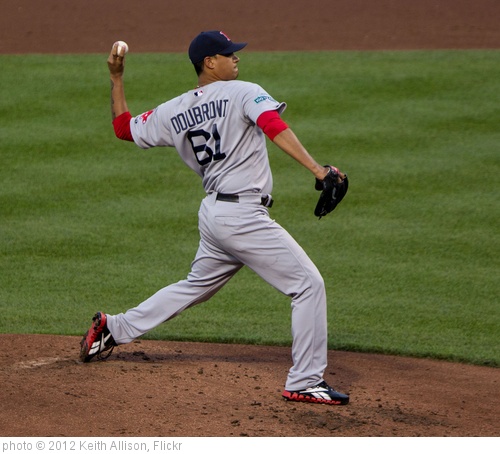 If you had to guess before the season started which pitcher in Boston’s starting rotation would have the lowest ERA entering June, you would have guessed incorrectly. Most would have said Jon Lester, some would have spoken in Josh Beckett’s favor, and maybe even a few would have taken a chance with Clay Buchholz (whoops). All of those men are, of course, the wrong answer. Because as the calendar flips to June, the man boasting the lowest ERA in the Red Sox rotation is also the youngest, the left-handed Venezuelan Felix Doubront, who picked up his fifth win of the season yesterday, pitching six solid innings against the Detroit Tigers.
If you had to guess before the season started which pitcher in Boston’s starting rotation would have the lowest ERA entering June, you would have guessed incorrectly. Most would have said Jon Lester, some would have spoken in Josh Beckett’s favor, and maybe even a few would have taken a chance with Clay Buchholz (whoops). All of those men are, of course, the wrong answer. Because as the calendar flips to June, the man boasting the lowest ERA in the Red Sox rotation is also the youngest, the left-handed Venezuelan Felix Doubront, who picked up his fifth win of the season yesterday, pitching six solid innings against the Detroit Tigers.
Doubront has had a surprising, if not unspectacular season so far. The fact that he leads the rotation in ERA probably says more about the starting rotation than it does about him. That being said, when spring training started, there was a chance that Doubront wasn’t even going to be a starter, so to get this production out of him is certainly welcome. Let’s take a closer look at his season.
The scouting report tells you pretty much everything you need to know about the lefty. He relies mostly on his fastball, which sits comfortably between 91-93 MPH. This has certainly proved to be the case this year, as he’s thrown a fastball 65.3% of the time. His favorite secondary pitch is the changeup (13.1% of the time this year) but he also features a curveball (12.8% of the time). It can be deadly when he can throw it for a strike, but that can sometimes be a struggle.
Speaking of struggling to throw strikes, that’s exactly what’s holding Doubront back right now, and maybe for the rest of his career. He’s sporting a 3.86 BB/9 and a 10.4 BB%. Simply put, he’s just walking too many batters. This is something that has plagued him throughout the minors, and it has carried over to his time in the big leagues. The issue isn’t that the walks are leading to too many runs, Doubront has done a good job of limiting the damage, the issue is that all the walks are driving up his pitch count, leading to him being lifted early in games. His longest outing of the year has been 6.1 innings, and that’s the only time this year he’s gone past the sixth. I was surprised to find that he only had five quality starts (in ten tries), but it makes sense as he usually struggles to pitch past the fifth inning. If he could cut down his walks, he’d be going much deeper into games, and then we’re talking about a very legitimate starting pitcher. He has swing and miss stuff, there’s no doubt about it, and his 9.48 K/9 is nothing short of impressive.
Here’s the interesting thing: there are a lot of numbers that indicate Doubront is only going to get better. For one, opponents have a .303 BABIP against him. This isn’t an absurdly high number, but it’s high enough that you could claim that he’s getting a bit unlucky. On top of that, his FIP (3.68) or xFIP (3.53) depending on which you prefer, are both lower than his ERA. It’s not much of a difference, but again, there is enough of a gap that one could reasonably predict that the best is still yet to come for Doubront.
Felix Doubront has allowed an earned run in every start he’s made this year. That’s not something usually associated with a dominant pitcher. Yet, one-fourth of the way through the season, he has a 1.1 WAR, and that’s good for best among the pitching staff, starter or reliever.
There’s something to be said for consistency, especially in a pitching rotation. Felix Doubront has been the only consistent pitcher on the Red Sox this year. Sure, he doesn’t have that complete game shut out, or that fifteen-strikeout game, but the Red Sox are 7-3 in games that he’s started, and that’s not a coincidence. Doubront has given his team a chance to win every time he’s taken the mound this year, and you certainly cannot say that about any other pitcher on this team. Beckett and Lester have both shown flashes of dominance at times, but when they give up zero runs in one start and seven in another, it doesn’t do a whole lot of good.
Remember, Doubront is still only twenty-four. This is his first full year as a starting pitcher at the major league level, as hard as it is to forget sometimes. If he continues to work on his control, and limiting his pitch count, it won’t be long until he’s a front-end starter for this team. That is, if he’s not already.
